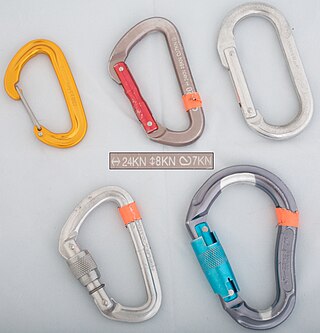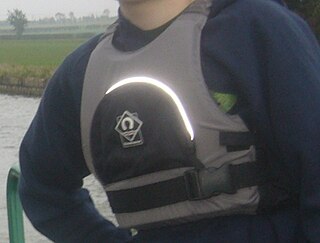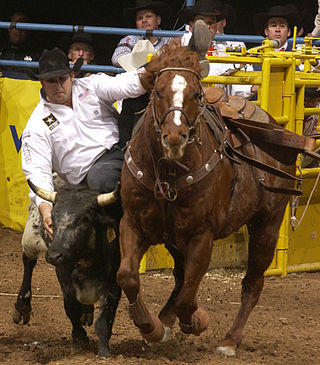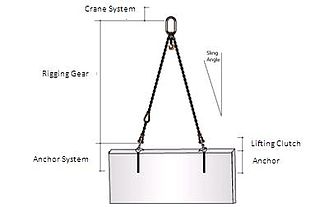
A carabiner or karabiner, often shortened to biner or to crab, colloquially known as a (climbing) clip, is a specialized type of shackle, a metal loop with a spring-loaded gate used to quickly and reversibly connect components, most notably in safety-critical systems. The word comes from the German Karabiner, short for Karabinerhaken, meaning "carbine hook," as the device was used by carabiniers to attach their carbines to their belts.
Tack is equipment or accessories equipped on horses and other equines in the course of their use as domesticated animals. This equipment includes such items as saddles, stirrups, bridles, halters, reins, bits, and harnesses. Equipping a horse is often referred to as tacking up, and involves putting the tack equipment on the horse. A room to store such equipment, usually near or in a stable, is a tack room.

A climbing harness is a device which allows a climber access to the safety of a rope. It is used in rock and ice climbing, abseiling, and lowering; this is in contrast to other activities requiring ropes for access or safety such as industrial rope work, construction, and rescue and recovery, which use safety harnesses instead.

Webbing is a strong fabric woven as a flat strip or tube of varying width and fibres, often used in place of rope. It is a versatile component used in climbing, slacklining, furniture manufacturing, automobile safety, auto racing, towing, parachuting, military apparel, load securing, and many other fields.

Rock-climbing equipment varies with the type of climbing undertaken. Bouldering needs the least equipment outside of shoes and chalk and optional crash pads. Sport climbing adds ropes, harnesses, belay devices, and quickdraws to clip into pre-drilled bolts. Traditional climbing adds the need for carrying a "rack" of temporary passive and active protection devices. Multi-pitch climbing adds devices to assist in ascending and descending fixed ropes. Finally, aid climbing uses unique equipment.

Bondage in BDSM is the activity of tying or restraining people using equipment such as chains, cuffs, or collars for mutual erotic pleasure. According to the Kinsey Institute, 12% of females and 22% of males respond erotically to BDSM.

Force Reconnaissance (FORECON) are United States Marine Corps deep reconnaissance companies that supply military intelligence to the command element of the Marine Air-Ground Task Force (MAGTF). Force Reconnaissance companies unlike USMC division reconnaissance report to the Marine expeditionary force (MEF) and provide direct action and deep reconnaissance during large-scale operations.

The Munter hitch, also known as the Italian hitch, mezzo barcaiolo or the crossing hitch, is a simple adjustable knot, commonly used by climbers, cavers, and rescuers to control friction in a life-lining or belay system. To climbers, this hitch is also known as HMS, the abbreviation for the German term Halbmastwurfsicherung, meaning half clove hitch belay. This technique can be used with a special "pear-shaped" HMS locking carabiner, or any locking carabiner wide enough to take two turns of the rope.

A D-ring is an item of hardware, usually a tie-down metal ring shaped like a capital letter 'D' used primarily as a lashing or attachment point. The term is found interchangeably spelled in different forms, such as: D ring, D-ring or dee-ring.
A parachute rigger is a person who is trained or licensed to pack, maintain or repair parachutes. A rigger is required to understand fabrics, hardware, webbing, regulations, sewing, packing, and other aspects related to the building, packing, repair, and maintenance of parachutes.

A backpack helicopter is a helicopter motor and rotor and controls assembly that can be strapped to a person's back, so they can walk about on the ground wearing it, and can use it to fly. It uses a harness like a parachute harness and should have a strap between the legs. Some designs may use a ducted fan design to increase upward thrust. Several inventors have tried to make backpack helicopters, with mixed results.

The Special Patrol Insertion/Extraction (SPIE) system was developed as a means to rapidly insert and/or extract a reconnaissance patrol from an area that does not permit a helicopter to land. SPIE has application for rough terrain as well as water inserts/extracts. It is an adaptation of the STABO rig.

Buoyancy aids are a specialist form of personal flotation device (PFD) used most commonly by kayakers, canoeists, people practicing rafting, and dinghy sailors. They are designed as a flotation aid, rather than merely a life-saving device and have several key differences to other PFD's and lifejackets. Some buoyancy aids may not provide the same high level of protection as lifejackets.

A breastplate is a piece of tack (equipment) used on horses. Its purpose is to keep a saddle from sliding back. It is also a safety feature—if the saddle's girth or billets break, a rider may have enough time to stop the horse and dismount before the saddle slips off the animal's back. The breastplate is used on both English and Western saddles. Western riding involving working cattle use a thicker sturdier style than in English riding or Western riding horse shows. A breastplate is most helpful for horses with large shoulders and a flat ribcage. A breast collar as part of a harness is used to pull a load.
The McGuire Rig was used to extract soldiers from the jungles of Vietnam. It would be suspended from a helicopter and used to extract soldiers from areas without a suitable pick-up zone. It was simple, inexpensive, and effective. Although less comfortable than the STABO harness, it did not require the soldiers to carry any special equipment. It was designed by Sergeant Major Charles T. McGuire, a member of Project DELTA, a Special Forces reconnaissance project.
Project DELTA was the first of the Reconnaissance Projects, which were special reconnaissance (SR) units named with a Greek letter. The Reconnaissance Projects were formed by the U.S. Military Assistance Command, Vietnam (MACV) during the Vietnam War to collect operational intelligence in remote areas of South Vietnam.

Helicopter Rope Suspension Technique (HRST) is a military term for techniques and methods of rappelling, fast roping, Special Patrol Insertion/Extraction (SPIE) and Jacob's Ladder operations. Helicopter Rope Suspension was developed as a means to insert and/or extract, by helicopter, ground forces into or from rough terrain, urban areas or water. HRST is designed to be used in situations wherein aircraft landings are impractical due to terrain or tactical situation.

A Petzl Stop is a descender used primarily in caving and formerly used for industrial rope access made by the French company Petzl.

Rigging is both a noun, the equipment, and verb, the action of designing and installing the equipment, in the preparation to move objects. A team of riggers design and install the lifting or rolling equipment needed to raise, roll, slide or lift objects such as heavy machinery, structural components, building materials, or large-scale fixtures with a crane, hoist or block and tackle.

On March 11, 2018, a sightseeing helicopter crashed into the East River off the Upper East Side of Manhattan, New York City, killing 5 people. Two passengers died at the scene, and three others were pronounced dead at the hospital. The pilot escaped the helicopter following the crash. The aircraft was operated by Liberty Helicopters for FlyNyon.















